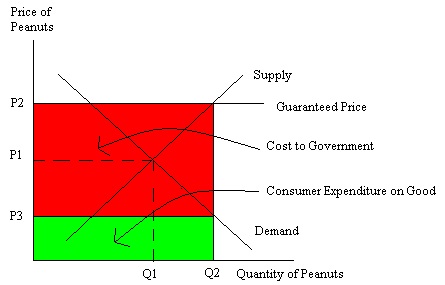Problem 1. The graph below depicts the initial situation in the market for peanuts.

Suppose the legislature passes an agricultural price guarantee program for the peanut market where the government promises peanut farmers they will receive a price of P2 per unit of peanuts where P2 is greater than P1. The government will provide a subsidy per unit of peanuts to insure that the final price peanut farmers receive for their product totals P2. The peanut farmers are told to produce the quantity they wish to produce given this guaranteed price, then they are to sell it at whatever price they can (P3), and then the government will pay a subsidy of (P2 – P3) on each unit that has been produced. On the above graph:
a. Draw in a line representing the “Price Guarantee” and label this line accordingly. Also label P2 on your graph.
b. Indicate on your graph the total quantity of the peanuts, Q2, the farmers will produce given this program.
c. On your graph indicate the price that consumers will pay, P3, when they purchase these peanuts.
d. On your graph indicate the area that represents the direct expenditures on peanuts by consumers.
e. On your graph indicate the area that represents the cost to the government of this subsidy program.
Problem 2. The domestic demand and supply curves for good X in a small closed economy are given below.
Domestic Demand: P = 100 – 2Q
Domestic Supply: P = 20 + 2Q
The world price for this good is $40. For each answer show your work to get full credit.
a. What is the value of consumer surplus (CS) in this closed economy?
b. What is the value of total surplus (TS) in this closed economy?
c. This market opens to trade. How many units of good X will be imported or exported into this small open economy?
d. What is the value of total surplus with trade (TStrade) for this small open economy?
e. Suppose a quota of 10 units is imposed by this economy’s government on this market. What will the price of good X be given this information?